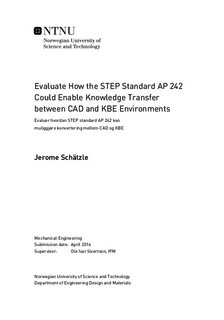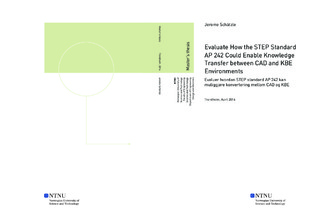| dc.description.abstract | For a complementary use of different digital development environments, the exchange of
product data between those environments is essential. This thesis evaluates the STandard for the Exchange of Product model data (STEP) in its potential to transfer product data between Computer Aided Design (CAD) and Knowledge Based Engineering (KBE) environments.
The most commonly used STEP protocols mainly provide the structures to represent geo-
metric data. As the International Organization for Standardization (ISO) aims to extend the standard with structures that can represent non geometric data during all the phases of a product s life cycle, they recently published the STEP AP242 standard, which contains additional data structures that can represent construction history, parameterized and constrained dimensions and features. These elements are used in CAD systems and provide information about the designers intentions during the construction process.
With the aim to provide a basis for the evaluation of STEP s potential in transferring such data, this thesis extensively reviews the standard and the related literature. In order to support the findings, an example STEP file is generated and transferred into the Adaptive Modeling Language (AML) KBE framework. More specifically, the example file is transferred with the help of parsers both for the EXPRESS structures defined in AP242 and for the STEP file that contains the data model. Finally, the implementation of an appropriate interface in AML enables the successful reconstruction of the example geometry.
Considering the literature review and the insights gained during the implementation of the example geometry, the potential of the STEP standard to provide the data structures to represent knowledge elements, such as construction history, can be approved. However, STEP AP242 is not yet implemented in commercial CAD systems. Moreover, the mapping between the EXPRESS and the AML structures incorporates some challenges. Thus, the STEP standard enables the transfer of such elements between CAD and KBE environments mostly theoretically. | |

